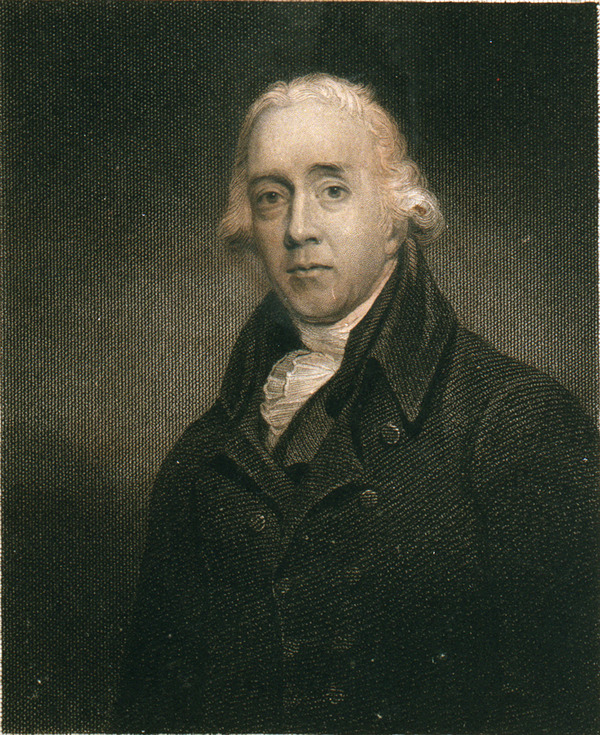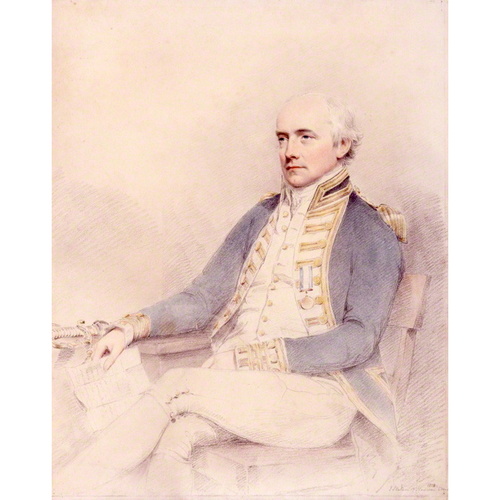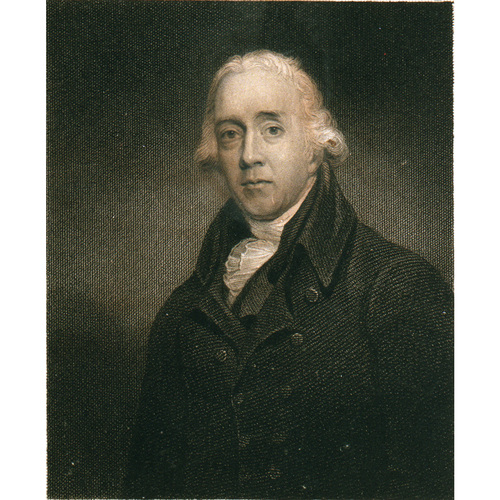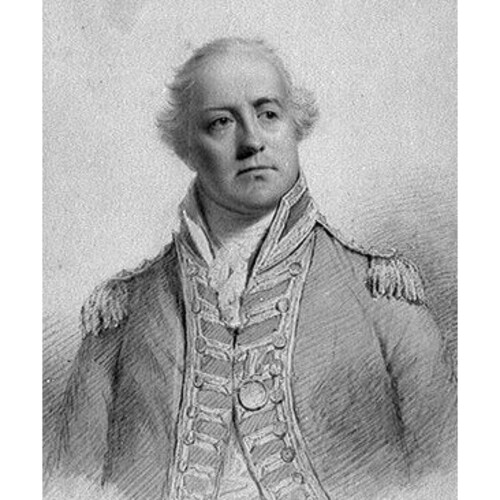
Source: Courtesy of Wikimedia Commons
GAMBIER, JAMES, 1st Baron GAMBIER, naval officer and governor of Newfoundland; b. 13 Oct. 1756 on the island of New Providence in the Bahamas, son of John Gambier, lieutenant governor of the Bahamas, and Deborah Stiles; m. July 1788 Louisa Matthew (Mathew) in London; they had no children; d. 19 April 1833 at Ivor House in Buckinghamshire, England.
James Gambier’s connection with the Royal Navy began at the age of 11, when his name was entered on the books of the Yarmouth guard-ship, commanded by his uncle James Gambier. On 12 Feb. 1777, when serving on the North American station, he was promoted lieutenant; the next year, while in command of the Thunder bomb, he was captured by the Comte d’Estaing’s squadron. Soon exchanged, in October 1778 he was made post captain. Gambier was a friend of the Pitt family, and his advancement in the navy was apparently due to this relationship rather than to the extent of his experience at sea. From 7 March 1795 to 19 Feb. 1801 he sat as a lord of the Admiralty; meanwhile, he was promoted rear-admiral on 1 June 1795 and vice-admiral on 14 Feb. 1799.
In the spring of 1802, shortly after the Treaty of Amiens was signed, Gambier was appointed governor of Newfoundland to replace Sir Charles Morice Pole. The lull in the war gave him some time to concern himself with civil affairs on the island. In the navy he was noted for his piety and his strict views on morality. In Newfoundland he earned a reputation for assistance to schools and charitable institutions and for encouragement of the clergy. When William Cull brought a captive Beothuk woman to St John’s, Gambier ordered that she be kindly treated, and she was later returned to her people.
Official British policy had always been, that Newfoundland was not a colony, but rather an adjunct to the fishery. The result had been injustices towards local residents and a lack of revenue for necessary works on the island. In giving leases to some lands for grazing sheep and cattle, Gambier hoped to provide inhabitants with a measure of security of tenure while at the same time bringing in revenue for the government. Recognizing that the fishery itself had essentially changed from migratory to sedentary, he recommended that vacant properties along the shore reserved at no charge for fishermen from Britain should instead be leased to local people. The value of continuity in administration was evident to him and he proposed the appointment of a permanent secretary. In December 1803, towards the end of his term, Gambier summarized his views for Colonial Secretary Lord Hobart. “The present system of policy,” he wrote, is “insufficient for effecting the happiness and good order of the community which is the chief end of all government. This I attribute to the want of a power in the Island for framing laws for its internal regulation, and for raising sums necessary to promote any measure of public utility.” Thirty years were to pass before such a government was established.
In the latter half of his term Gambier had been obliged to turn his attention to defence, since war resumed in June 1803. At that point the garrison at St John’s consisted of 63 artillerymen. Brigadier-General John Skerrett* was authorized to raise a regiment of 1,000 men, but recruiting was difficult because it was banned during the fishing season. Gambier remained apprehensive about local defence throughout the time taken to enlist and train the force.
On 15 May 1804 Gambier was reappointed to the Admiralty, being succeeded in Newfoundland by Sir Erasmus Gower*. He was made admiral of the blue on 9 Nov. 1805 and commanded the fleet which in 1807 took possession of the Danish navy. This success was rewarded with a barony in November and command of the Channel fleet from the following spring until 1811. Gambier was named head of the British commission that negotiated peace with the Americans in 1814. Two other distinctions followed, the gcb on 7 June 1815 and promotion to admiral of the fleet on 22 July 1830. He died at his home, Ivor House, in 1833. Although his time in Newfoundland had been short, his career reflects that moral earnestness and desire for progress which gave rise in Britain to the great reform movements of his day.
PRO, CO 194/43: 75, 171–78, 323. Gentleman’s Magazine, 1788: 365. Admiralty officials, 1660–1870, comp. J. C. Sainty (London, 1975). G. E. Cokayne, The complete peerage of England, Scotland, Ireland, Great Britain and the United Kingdom, extant, extinct, or dormant (new ed., ed. Vicary Gibbs et al., 13v. in 14, London, 1910–59). DNB. G.B., ADM, Navy list, 1808. John Marshall, Royal naval biography . . . (4v. in 6 and 2v. supp., London, 1823–35), 1: 74–86. James Ralfe, The naval biography of Great Britain . . . (4v., London, 1828), 1: 82–90. Joseph Hatton and Moses Harvey, Newfoundland, the oldest British colony; its history, its present condition, and its prospects in the future (London, 1883). Howley, Beothucks or Red Indians. William James, The naval history of Great Britain, from the declaration of war by France in 1793 to the accession of George IV . . . (new ed., 6v., London, 1860), 4. G. W. L. Nicholson, The fighting Newfoundlander; a history of the Royal Newfoundland Regiment (St John’s, [1964?]). Prowse, Hist. of Nfld. (1895), 375–77.
Cite This Article
Frederic F. Thompson, “GAMBIER, JAMES, 1st Baron GAMBIER,” in Dictionary of Canadian Biography, vol. 6, University of Toronto/Université Laval, 2003–, accessed January 9, 2026, https://www.biographi.ca/en/bio/gambier_james_6E.html.
The citation above shows the format for footnotes and endnotes according to the Chicago manual of style (16th edition). Information to be used in other citation formats:
| Permalink: | https://www.biographi.ca/en/bio/gambier_james_6E.html |
| Author of Article: | Frederic F. Thompson |
| Title of Article: | GAMBIER, JAMES, 1st Baron GAMBIER |
| Publication Name: | Dictionary of Canadian Biography, vol. 6 |
| Publisher: | University of Toronto/Université Laval |
| Year of publication: | 1987 |
| Year of revision: | 1987 |
| Access Date: | January 9, 2026 |





